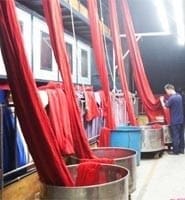Nike and DyeCoo Textile Systems BV, a company that developed what it claims to be the first commercially available water-free textile dyeing system, have established a strategic partnership for the exploitation of this innovative process using carbon dioxide in the dyeing process . “We believe that this technology has the potential to revolutionize the textile industry and we want to collaborate with progressive dye companies, textile manufacturers and clothing brands to foster this technology and spread it across the industry,” explains Eric Sprunk, vice president of? merchandising and Nike product. Nike has been exploring this technology for the past eight years and hopes to introduce clothing made from water-dyed fabrics later this year. Likewise, the brand wants to expand the technology to larger production volumes. In addition to not using water, the system is allegedly capable of reducing energy consumption, does not require auxiliary or drying chemicals ?? and it is twice as fast as conventional processes. “The technology can also improve the quality of the dyed fabric, allows greater control over the dyeing process, allows for new dyeing capabilities and transforms the dyeing of fabrics so that it can occur anywhere”, adds Reinier Mommaal, CEO of DyeCoo. The North American sports giant is one of several companies involved in the so-called Detox challenge, started last year by pressure from the environmental group Greenpeace to eliminate the discharge of dangerous chemicals from its supply chains by 2020. One of the issues that were highlighted in a joint roadmap of measures they intend to take to achieve the objective is the large volume of water used in dyeing, finishing and other processes ?? and the fact that wastewater treatment varies from company to company. Indeed, conventional textile dyeing requires substantial amounts of water. On average, about 100 to 150 liters of water are currently needed to process one kilogram of textile material ?? and industry analysts estimate that more than 39 million tons of polyester will be dyed annually by 2015. Nike expects DyeCoo’s supercritical fluid carbon dioxide to have a particularly positive impact in Asia, where much of the textile dyeing occurs. As this technology is implemented, the large quantities of water used in conventional textile dyeing will no longer be necessary, nor will the proportional use of energy from fossil fuels consumed to heat these large volumes of water. The elimination of water in the textile dyeing process also suppresses the risk of effluent discharges, a known environmental hazard. The CO2 used in the DyeCoo dyeing process is recovered and reused. The dyeing process without water is currently limited to polyester fabrics, but ongoing research has made it possible to extend its application to other natural and non-natural fabrics. The elimination of water in the textile dyeing process also suppresses the risk of effluent discharges, a known environmental hazard. The CO2 used in the DyeCoo dyeing process is recovered and reused. The dyeing process without water is currently limited to polyester fabrics, but ongoing research has made it possible to extend its application to other natural and non-natural fabrics. The elimination of water in the textile dyeing process also suppresses the risk of effluent discharges, a known environmental hazard. The CO2 used in the DyeCoo dyeing process is recovered and reused. The dyeing process without water is currently limited to polyester fabrics, but ongoing research has made it possible to extend its application to other natural and non-natural fabrics.
Reference: https://www.portugaltextil.com/nike-quer-tingir-sem-agua/

